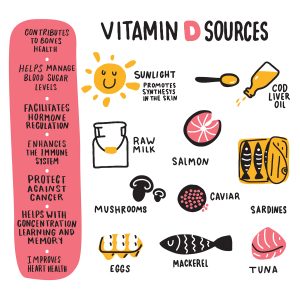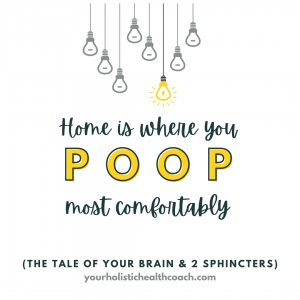The Deal with Vitamin D, Health and Immunity
Vitamin D is an overachieving, jack of all trades, hands-into-everything Casanova. D’s relationship with your body is complicated, but full of love.
So, what is the deal with Vitamin D, health and immunity? To understand that, let’s look at what Vitamin D actually is! “Vitamin” D is not actually a vitamin at all, but rather, a fat-soluble hormone that directs processes in the body rather than just supporting them.
6 Reasons You Can’t Live Without Vitamin D:
- Proper levels of vitamin D are needed for your cells to use the thyroid hormone.
- It helps cells form correctly and cleans up any misbehavers.
- Vitamin D facilitates the absorption of calcium.
- It regulates insulin secretion and insulin sensitivity and balances blood sugar.
- Vitamin D is critical to the success and function of your immune system.
- Therapeutic doses of vitamin D are helpful in managing chronic pain and depression.
Get the picture? Vitamin D is an inside operator. The big deal about the big D is, without it, you risk your body tanking in a variety of ways. We are talking about increased risk of autoimmune disease, colon and breast cancer, depression, and chronic pain.
The Bad News:
According to this article, in 2014 an estimated 50% of all people worldwide are deficient in Vitamin D. Almost 70% of adults in the U.S. were deficient. Whoa!
What is more troubling now is that reports show that 80% of the people who are ending up hospitalized with moderate to severe cases of Covid19 are Vitamin D deficient!
When many people lack enough of the stuff that directly modulates almost every single cell in the body, we have a global health problem.
For my friends with thyroid concerns, it is important to note that inadequate Vitamin D may be impacting thyroid hormone production. People suffering from autoimmune thyroid conditions, such as Hashimoto’s or Graves’ Disease should get their Vitamin D status evaluated. Vitamin D deficiency is also a major factor in thyroid cancer.
The Good News:
That same 2010 study showing the link between Vitamin D deficiency and thyroid cancer also found that Vitamin D is protective of thyroid cells, and is actually preventing cells from becoming cancerous.
Plenty of vitamin D is a sunbeam away! Bikini and speedo clad bodies exposed to enough UVB sun rays just to pink you up a bit can manufacture enough Vitamin D to reach an equivalent of 25,000 IU. Incredibly, your body is a Vitamin D factory not only when exposed to enough sun, but also the Vitamin D that you make lasts at least twice as long as supplemented Vitamin D in your bloodstream… But there is a trick to it!
How Do You “Make” Vitamin D?
Want to be the best D-maker you can be? Of course, you do! There are a few things you need to know. When UVB rays hit the surface of your skin, your skin begins converting a cholesterol derivative into vitamin D3. The problem is that the D3 formed on your skin does not immediately make it to your bloodstream. The absorption process takes up to 48 hours and requires that you do not scrub or soap it off (you are thinking about stinking, I know).
Healthy Action Steps:
- Start by getting your blood level of 25-hydroxy so you have a baseline number established.
- Next, begin trying to catch some rays every day. 10-15 minutes may be all you need. Make the best decision based on your location and your personal risk for melanoma.
- Post sunning, in the shower, wash pits and private bits. Just rinsing off the rest will do.
- Finally, re-checking your levels in a few months and seeing if you are making a difference.
How Much Do You Need?
The Institute of Medicine recommends 600 IU daily for adults through age 70 and 800 IU daily thereafter. Intake does not really do much for you if you do not know your blood level though, so ask your doctor for that 25-hydroxy test. Blood levels about 30 ng/mL are considered adequate. However, for people with chronic illness and autoimmune disease and for COVID-19 protection, many integrative doctors recommend blood levels of 60-80 ng/ml.
Supplementing
Talk to your doctor about a good starting amount for supplementation if your numbers are not in range with sun exposure or if you can’t sunbathe because of a history of skin cancer or if you’re at high risk for melanoma.
- A good Vitamin D supplement will be oil-based Vitamin D3.
- You can choose liquid drops or capsules.
- Re-check your levels every other month to avoid toxicity.
- 500 mcg Vitamin K2, in the form of MK4 or MK7, has been shown to enhance the absorption of Vitamin D and helps prevent any calcium liberated by Vitamin D supplementation from being deposited in muscle tissue rather than in bones or teeth. Note: do NOT supplement K2 if you are on a blood thinner or if you have Factor V Leiden.
- If you cannot get your level to raise above 30 with adequate supplementation, consider getting tested for a defect on the VDR gene that could be prohibiting your body from absorbing Vitamin D.
Food Sources of Vitamin D and K2

sunlight, raw milk, cod liver oil, salmon, caviar, sardines, mushrooms, eggs, mackerel, tuna
One of the few great sources of Vitamin D as far as food goes is mushrooms. Here are some other ideas:
- Adding a handful of ‘shrooms to a beautiful miso broth or sautéing them in a stir-fry with other veggies!
- Making a tall glass of your favorite juice or smoothie and go enjoy it while lounging in the sun under a gorgeous blue sky.
- Tapping in to Vitamin D in eggs to make omelets or scrambles.
- Enjoying a Caesar dressing made with sardine instead of anchovy (if you eat fish).
A vitamin K rich diet includes lots of cabbage, kale, spinach, Swiss Chard, green leafy vegetables, broccoli, cauliflower, brussels sprouts, wheat bran and sauerkraut. Eating these foods with a little healthy fat, like that from olive oil, coconut oil or avocado will help boost absorption. Like K2 supplementation, be cautious of a major increase in K-rich foods if you have clotting issues.
Conclusion
Do you feel like you have a better understanding of the Deal with Vitamin D Health and Immunity?
Are you struggling to get your Vitamin D status into the healthy range?
Are you more concerned that your Vitamin D level is low now that Covid 19 is such a huge factor in world health?
If you want to dig in more deeply and get personalized support, let’s get you on the schedule. Email sarah@yourholistichealthcoach.com and we can get started!
More information




















